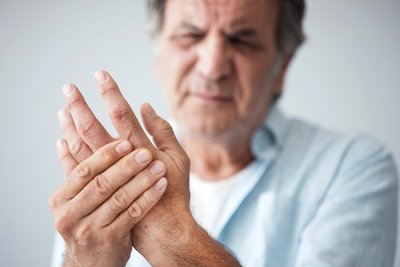Arthritis comes with many unpleasant symptoms, including stiffness, swelling, discomfort and a decreased range of movement. It can also bring pain to the affected joints and tissues around the joints.
Unfortunately it’s not uncommon for people to spend years wondering what’s good for arthritis pain, trying different treatments and yet not finding relief. But that doesn’t mean that their arthritis pain is not treatable.
Below you’ll learn about several treatments that can be effective if prescribed and overseen by a fellowship-trained orthopedic expert.
A fellowship-trained orthopedic expert will likely recommend a treatment plan that includes multiple of the following ways to treat arthritis pain:
1. Physical therapy
Physical therapy is one a crucial step in treating arthritis pain. A course of physical therapy for arthritis that is designed by an orthopedic expert will help you build strength and learn to move in ways that protect the joint affected by your arthritis. That may mean training you out of poor posture or ways of moving that may be aggravating your symptoms.
2. Corticosteroid injections or shots
A first line of treatment for arthritis pain often involves a one-two punch of physical therapy and cortisone shots. Cortisone is a corticosteroid, a medication that helps calm inflammation, according to the Arthritis Foundation. Shots of cortisone help make the physical therapy more effective because they can give the patient a window of relief from arthritis pain to engage a physical therapy regimen. Cortisone alone is unlikely to be an effective long-term treatment for arthritis pain.
3. Gel injections
Gel injections administered to the affected joint work in a similar way to cortisone, and can have a longer lasting impact on arthritis pain. These injections — also called hyaluronic acid supplements, or viscosupplementation — are another option if initial treatment with cortisone and physical therapy fail to effectively reduce or diminish pain. Like cortisone, gel injections have an anti-inflammatory effect, and they also work like a lubricant or a shock absorber in the affected joint. An orthopedist would likely continue to prescribe a regimen of physical therapy to improve the impact of the injections.
4. Surgery, including joint replacement
If all other treatment options fail and arthritis pain persists, orthopedic surgery may be needed. Joint surgery could include total joint replacement, arthroplasty or any number of other procedures — what makes sense will depend on your condition and which joints are affected, as well as age and other factors. Fortunately, partial and total joint replacement surgery are often being done on outpatient basis these days, which means you could go home on the same day as your surgery.
Whether you’re experiencing arthritis pain from osteoarthritis, rheumatoid arthritis or another condition, the treatments above can help. The best way to get arthritis pain under control and improve your quality of life is to talk to an orthopedic expert about what makes sense for you.

